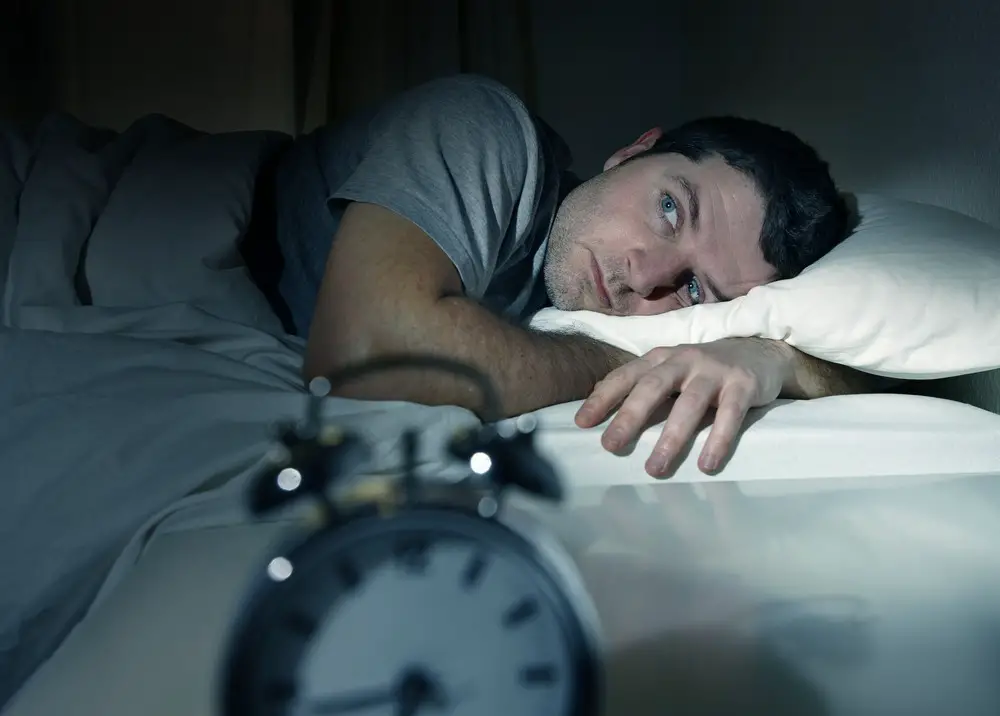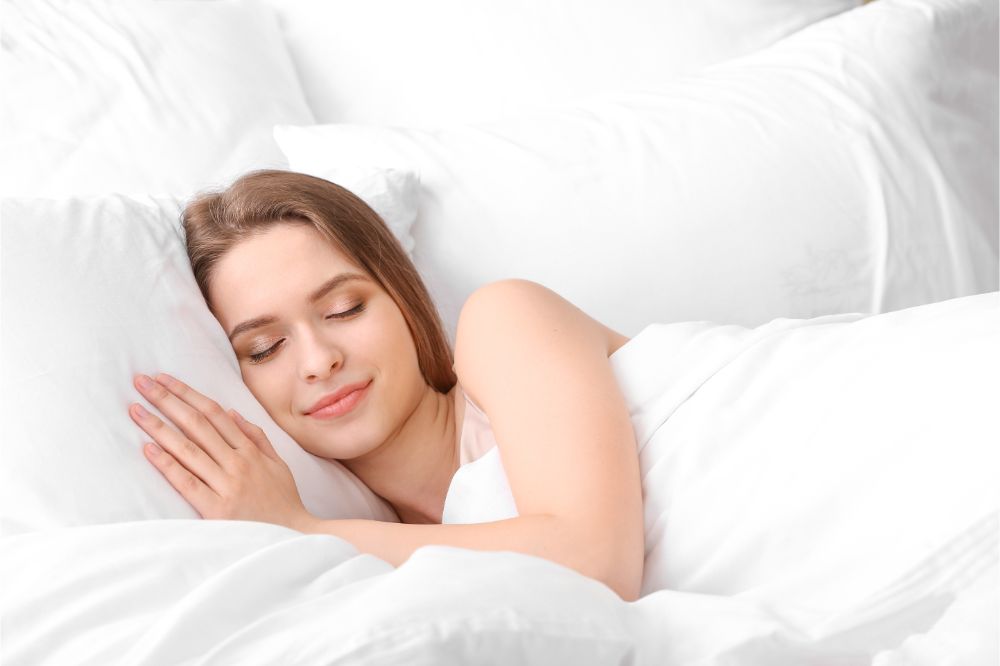As a BetterHelp affiliate, we receive compensation from BetterHelp if you purchase products or services through the links provided
Struggling to catch some Z’s with sleep apnea can be an absolute nightmare. Side sleeping, experts say, might just be your ticket to sweeter dreams by keeping airways clear. This post will guide you through the best positions that promise a good night’s rest and better health.
Let’s find your perfect sleep spot!
Ideal Sleep Positions
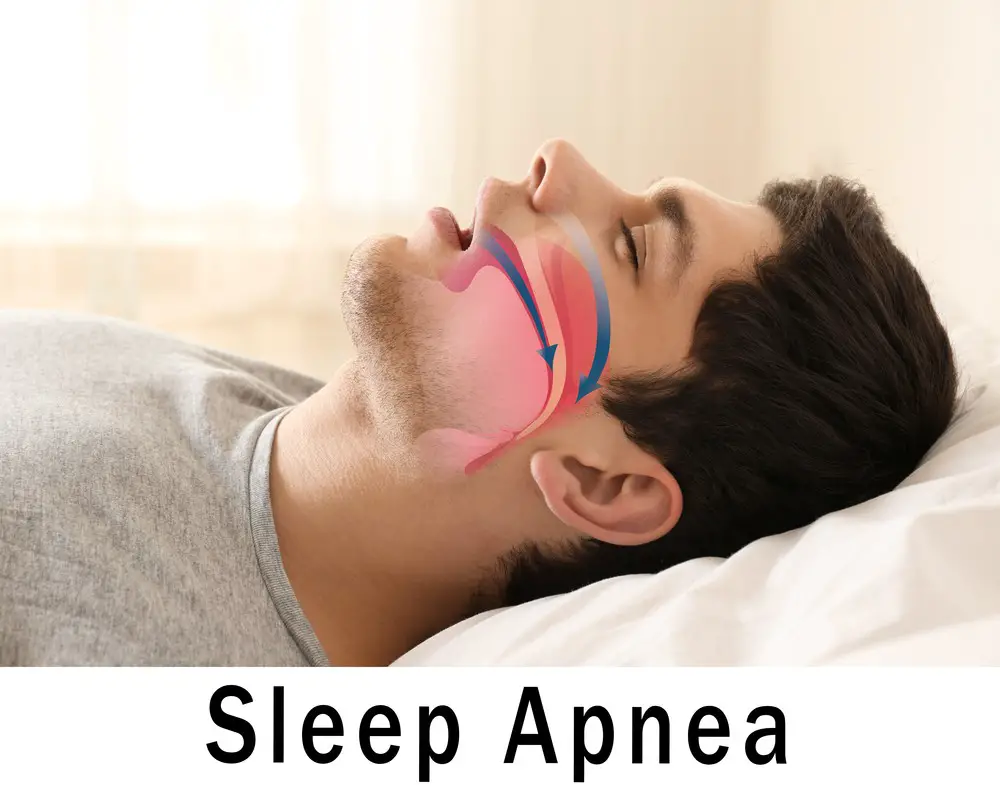 Exploring the ideal sleep positions can be a game-changer for those battling sleep apnea, as finding the sweet spot could significantly improve breathing and overall sleep quality.
Exploring the ideal sleep positions can be a game-changer for those battling sleep apnea, as finding the sweet spot could significantly improve breathing and overall sleep quality.
Let’s dive into how tweaking your nightly posture might lead to more restful nights and brighter days.
Sleeping on Your Side
Sleeping on your side, or lateral sleeping, is a game-changer for people with obstructive sleep apnea. This position helps open up your airways more than other positions might.
It effectively reduces snoring and the troublesome symptoms of sleep apnea that can disrupt a good night’s rest. As you settle in for the night, keep your back fairly straight to maximize these benefits.
Choose the right or left side based on comfort and habit; tilting your head slightly downward can further prevent your chin from pressing against your chest—an essential move for keeping those airways clear.
Side sleeping assists with breathing and may relieve neck and back pain by maintaining proper spinal alignment. Ready to switch things up? There’s more than one ideal position if side sleeping is not for you.
Sleeping on Your Stomach
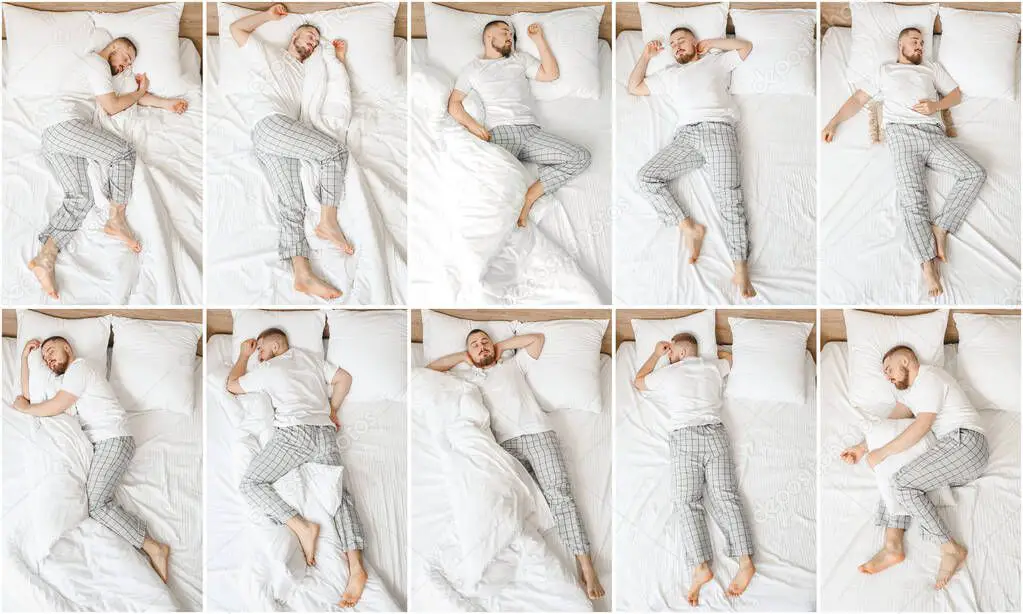 Sleeping on your stomach might be a good move for snoring and sleep apnea sufferers. This prone sleeping position often keeps the airway more open, which can cut down on the disruptive breathing pauses so common in those with sleep apnea.
Sleeping on your stomach might be a good move for snoring and sleep apnea sufferers. This prone sleeping position often keeps the airway more open, which can cut down on the disruptive breathing pauses so common in those with sleep apnea.
However, it’s not all smooth sailing; while stomach-sleeping benefits include potentially quieter nights, they have some downsides.
People who opt for this position may wake up with a stiff neck or lower back pain. That’s because lying face-down can strain your spine and put extra pressure on your muscles and joints.
Despite its advantages for breathing easier at night, think twice if you have chronic pain issues – there could be more restful positions that won’t leave you achy in the morning.
The Role of Head Positioning
Keeping your head in the right position can make a big difference for those with sleep apnea. Turning your head slightly to the side helps keep the airway open if you sleep on your back.
This simple adjustment prevents tissues in the throat from blocking airflow, which often causes snoring and breathing difficulties.
For stomach sleepers, placing their forehead on a pillow with their head facing down may seem unusual, but it opens up the airways effectively. This position properly aligns the head and neck, reducing respiratory health issues during sleep.
It’s all about maintaining clear pathways so that each breath is as effortless as possible throughout the night.
Optimal Sleeping Positions
Optimal sleeping positions can make a significant difference for those with sleep apnea. These positions promote better breathing and improve overall sleep quality.
- Side Sleeping: This position keeps the airway open by naturally aligning the spine and neck. It also prevents the tongue from falling back into the throat, which can block airflow.
- Left Side Preference: Among side-sleeping options, favoring the left side has decreased apnea episodes because it promotes better circulation and reduces acid reflux.
- Elevate Your Head: Raise the head of your bed or use a wedge pillow to elevate your upper body. This angle helps prevent the airway from collapsing due to gravity’s effect on your throat tissues.
- Stomach Sleeping: While not as ideal as side sleeping, lying on your stomach can prevent the tongue from obstructing the airway. Use a flat pillow to avoid neck strain in this position.
- Avoid Back Sleeping: Lying on your back often worsens sleep apnea symptoms. Gravity pulls the tongue and soft tissues back, restricting airflow even further.
- Try Adjustable Beds: Beds that allow for head elevation can create an optimal angle for breathing without using multiple pillows, which might shift during sleep.
- Use Sleep Apnea Pillows: Specialized pillows designed for sleep apnea can help maintain a proper sleeping posture throughout the night, reducing snoring and improving airflow.
Sleep Apnea: Finding the Perfect Position
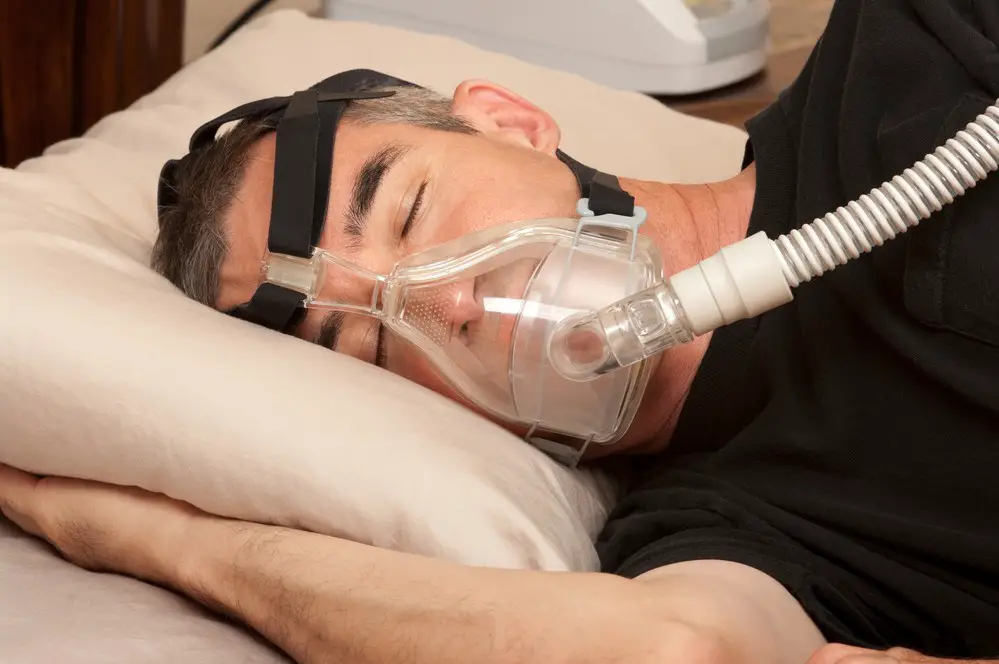 As we consider optimal sleeping positions, it becomes crucial to zero in on the best arrangement for managing sleep apnea. For those experiencing this condition, identifying a position that minimizes breathing interruptions is key.
As we consider optimal sleeping positions, it becomes crucial to zero in on the best arrangement for managing sleep apnea. For those experiencing this condition, identifying a position that minimizes breathing interruptions is key.
Side sleeping surfaces are a standout choice because they help maintain an open airway throughout the night. Elevating the head while resting on your side can prevent tongue collapse and promote easier breathing.
If you’re grappling with sleep apnea, experimenting with different angles of head elevation could be beneficial. Adjustable beds or foam wedges offer personalized options to find that sweet spot where air flows freely, and snoring diminishes.
Recognizing that each person’s body differs, adjusting your sleep setup could significantly improve the quality of rest you achieve each night.
Sleep apnea, a common sleep disorder characterized by interruptions in breathing during sleep, often leads to restless nights and daytime fatigue. However, finding the perfect sleeping position can significantly alleviate its symptoms. Among the best sleeping positions for sleep apnea, experts often recommend sleeping on one’s side rather than on the back.
This position helps prevent the relaxation of throat muscles, which can obstruct the airway and trigger apnea episodes. Elevating the upper body slightly with pillows can also help keep the airway open, reducing the severity of sleep apnea symptoms.
Moreover, avoiding sleeping on the stomach is advisable as it can strain the neck and make breathing more difficult.
While finding the perfect position may require some experimentation, these adjustments can lead to more restful sleep and improved overall health for individuals with sleep apnea.
Consulting with a healthcare professional for personalized advice and treatment options is essential in managing this condition effectively.
Sleeping Strategies for Sleep Apnea
After pinpointing the perfect position, adopting effective sleeping strategies to manage sleep apnea is crucial. These tactics focus on maintaining the correct posture throughout the night and enhancing overall sleep quality.
- Utilize a body or pregnancy pillow: A full-length body pillow can support and help maintain side sleeping, preventing you from rolling onto your back where airway obstruction is more likely.
- Elevate your head: Raising the head of the bed by about four inches can relieve pressure on the airways. Use wedge pillows for targeted elevation that helps keep breathing pathways open.
- Invest in an adjustable mattress: An adjustable base allows you to easily lift your upper body into a position that reduces airway closure and manages sleep apnea symptoms effectively.
- Consider positional therapy: Wearable devices like sleep apnea positional trainers can alert you when on your back, prompting a switch to the side or stomach sleeping without waking fully.
- Stay consistent with bedtime routines: Going to bed and waking up simultaneously every day stabilizes your sleep patterns, making it easier to stick to beneficial sleeping habits for managing apnea.
- Avoid alcohol and sedatives before bed: These substances relax throat muscles, increasing the risk of airway obstruction. Steer clear for better control over breathing difficulties while asleep.
- Exercise regularly during the day: Physical activity promotes muscle tone, including in the muscles around the throat, helping reduce snoring and interrupted breathing due to obstructive sleep apnea.
Enhance Your Sleep with These Positions
Sleep apnea causes disrupted breathing during sleep, resulting in poor rest. Finding positions that maximize airflow can enhance sleep quality.
Sleeping on your side is often most effective for sleep apnea sufferers. Keeping your airway straight and open by stacking your neck, spine, and hips while tilting your head forward eases breathing. Try hugging a pillow to maintain alignment.
Elevating your upper body with extra pillows or a wedge also improves breathing when on your back. Just avoid sinking into a slumped position, which collapses airways.
Some find sleeping at a 30-degree incline in a reclined chair adequate. Avoid sleeping flat on the back, which worsens apnea.
Experiment with adjustments like raising the bed’s head, wearing a CPAP machine, or using nasal dilators or strips to enhance airflow.
Finding the proper sleep position for your body type, apnea severity, and comfort takes trial and error. Be consistent each night to train your body. With airflow-optimizing positions, you can wake refreshed and ready to take on the day.
Sleep Apnea Relief: Best Sleeping Postures
Sleep apnea disrupts breathing during sleep, decreasing oxygen levels and depriving the body of quality rest. Finding sleeping positions that open up airway passages can provide relief. Focus on postures that avoid obstruction.
Sleeping on your side is often most beneficial for keeping airways open. Place a pillow between your knees and hug another to your chest. This stabilizes your body, prevents the tongue from falling back, and aligns the head, neck, and spine. Sleep towards the edge of the bed so your head tilts slightly forward, maximizing airflow.
Elevating your upper body can also help when sleeping on your back. Prop yourself up with a wedge pillow or stack of sturdy pillows under your shoulders and head. Avoid sinking into a slumped position, which collapses the airway. A 30-60 degree incline is optimal. Using a CPAP machine makes this position even more effective.
Inclined beds and recliners are another option, as the angled position improves breathing. Do not sleep flat on your back, as gravity causes your tongue and tissues to block the throat. Avoid stomach sleeping as well.
Experiment with pillow props, nasal strips, chin straps, and pillow wedges to find your ideal position. Consistency is key to experiencing full benefits. With some adjustments, you can find sleeping postures that minimize apnea symptoms, giving your body the restorative rest it needs.
Position Matters: Sleep Apnea Tips
Side sleeping can be a game-changer for those battling with sleep apnea. Lying on one’s side decreases the likelihood of tongue obstruction and airway blockage, allowing smoother breathing throughout the night.
This position also helps alleviate snoring, providing a quieter sleep environment, which benefits the individual and their bed partner.
Elevating your head while sleeping on your side offers additional benefits. It encourages the airways to remain open by reducing the pressure on your throat muscles. Supportive pillows designed for this purpose can keep you comfortably positioned throughout the night.
For optimal results in managing symptoms, maintaining a straight back aligns with recommended positional therapy techniques focusing on overall breathing improvements for individuals with obstructive sleep apnea.
Sleep Apnea and Comfortable Sleeping Positions
Finding a sleeping position that is both comfortable and effective for managing sleep apnea can transform a night of rest. Side sleeping, especially on the left, has been shown to significantly decrease the frequency of breathing pauses compared to other positions.
This could be due to improved blood flow and less strain on the heart. It’s also easier for your body to maintain open airways when lying on your side.
Elevating the head while sleeping on your back relieves obstructive sleep apnea symptoms by reducing airway collapses that cause disruptions during sleep. Special pillows designed for this purpose or adjusting the head of an adjustable bed can significantly affect comfort levels and symptom reduction.
Proper alignment is key; ensuring there are no unnecessary bends in the neck that could worsen obstruction is vital for a restful night’s sleep.
Experimenting with these variations could lead to discovering which one promotes better sleep patterns and minimizes apnea events, improving overall health and daytime function. After focusing on how various positions can aid someone with sleep apnea, exploring additional strategies individuals have used successfully in their journey toward peaceful rest is essential.
Conclusion
Switching up your sleeping position might just hold the key to a better night’s rest when battling sleep apnea. Consider tucking into bed on your side or with elevated head support to keep those airways clear and snores at bay.
Exploring different mattress types and specialized pillows can also be game-changers in minimizing disturbances throughout the night. Embrace these simple changes and unlock the door to more restful slumber, ensuring that every morning starts on a brighter note.
- Breaking the Silence: Why Men’s Mental Health Matters More Than Ever - April 15, 2025
- How to Transform a Home’s Patio Space into a Relaxing Space - March 23, 2025
- 5 Strategies to Use a Cell Phone to Help Manage Your Stress - March 23, 2025
This site contains affiliate links to products. We will receive a commission for purchases made through these links.


